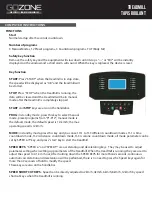
HOME FITNESS | Remise en forme à domicile
TREADMILL
TAPIS ROULANT
MAINTENANCE
RUNNING BELT ADJUSTMENT
Belt tension adjustment is very important as it ensures an optimal and firm surface. The running belt is
pre-adjusted at the factory but may loosen during transport or during use.
We recommend that you turn off the power after running the treadmill for 60 minutes.
The belt needs to be tensioned when it starts to slip, slide sideways, or curl during training.
Place the equipment on a flat surface. Run the equipment at about 6–8 km/h and note the deviation of the
running belt.
Adjustment must be made on the right and left side of the rear rollers to tension the belt with the Allen wrench
provided. The adjusting bolt is located at the end of the rails as the diagram shows:
A belt that is too loose may stop despite a running motor.
Do not over tighten the belt as it may damage the motor, shaft, or bearings.
A correctly stretched belt can be lifted on the sides up to about 5–7.5 cm. The belt is tensioned correctly if
you can fit three fingers under it.
CENTRING THE RUNNING BELT
The treadmill can be deviate to one side for different running modes (generally due to having more weight on
one leg than the other). That is why it requires adjustment from time to time. To centre the belt, set the speed to
3km / h and check which way it drifts:
•
•
•
INCREASING BELT TENSION
Place the Allen key in the left rear bolt and turn it 90° clockwise. This way, you will stretch the rear roller and
increase the belt tension. Repeat the procedure with the other bolt . Make sure that both bolts are tightened the
same.
REDUCING BELT TENSION
To reduce the tension, repeat the previous procedure backwards, turning the bolts counterclockwise.
Fig. A
Fig. B
Fig. C
Fig. B
Fig. C
Fig. C
If it deviates to the right, place the wrench on the right rear bolt and turn 90 ° clockwise. Check that it has
been centred; if it is not yet centred, rotate 90 ° more clockwise.
If it deviates to the left, place the wrench on the left rear bolt and turn 90 ° counterclockwise. Check that it
has been centred; if it is not yet centred, turn 90 ° more counterclockwise.
•
•










































